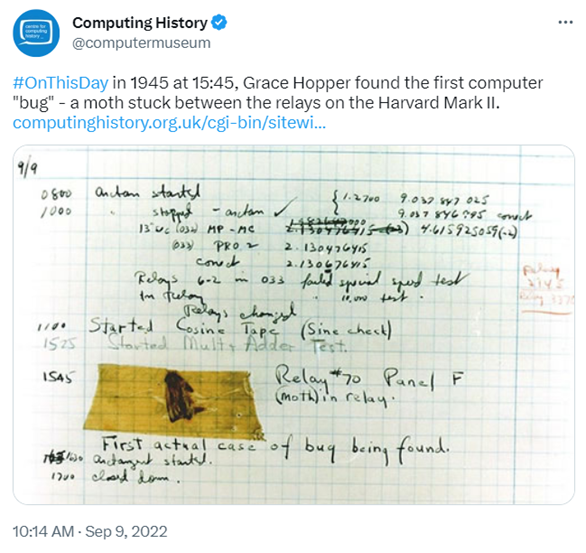Claim learners’ certificates by Friday 11 July. If your qualification doesn’t include an external assessment and learners are expecting results in August, make sure to claim certificates by this date. For qualifications with external assessments, claim within two working days of receiving confirmed results. Find out more on our timely delivery of results page.
Celebrating pioneering women in STEM
As of 2020, there are over one million women working in core-STEM roles in the UK – yet, women still make up just over a quarter (26.9%) of the UK's core-STEM workforce.
And, whilst women engineers have seen a good uplift and now account for 13.6% of the workforce (up from 12.5% in December 2021), as well as growing numbers of women working as science professionals (51.5%), the number of women in IT technician roles has unfortunately fallen from 26.3% in 2021 to 25.9% in 2022.
As such, I wanted to take a look back through some technological milestones and celebrate the incredible impact that some of the great female pioneers have had on this sector, who continue to be an inspiration for young girls looking to enter into careers in STEM (science, tech, engineer and maths) in the future.
Ada Lovelace
No article could be complete without first considering Ada Lovelace. Born in 1845, Ada, the daughter of Poet Lord Byron, was an English writer and mathematician. Through her close friendship with Charles Babbage, the developer of the analytical engine computer, Ada wrote about how the engine could calculate numbers.
Introducing concepts of ‘loops’ and ‘subroutines’ places her as the earliest computer programmer. Ada’s contribution to this field is still honoured to this day.
The ENIAC programmers
The ENIAC (Electronic Numerical Integrator and Computer) was used during World War II to calculate the trajectory of artillery, as it was nearly 2.5 thousand times faster than human calculation. The job of operating this ‘machine’ was given to six women: Frances Bilas, Jean Jennings, Ruth Lichterman, Kay McNulty, Betty Snyder and Marlyn Wescoff.
Originally recruited to the Army as female ‘computers’, these six women had to figure out how the machine worked and how to program it. This was a process of equation analysis, patch cables and switches.
Grace Hopper
All programming languages need to come from somewhere. After World War II, Grace Hopper worked on many computer projects but also developed a tool to translate English into machine code – the first ‘complier’. This later inspired the development COBOL (COmmon Business Oriented Language), as well as other key advancements in programming.
Whilst we're on the topic – have you ever considered why we use the phrase ‘computer bug’? Well, after finding a moth stuck in a computer, Grace is said to have made up this phrase!
Image showing Grace Hopper's original notes on her "bug" discovery. Posted by @computermuseum
Hedy Lamarr
An Austrian-American actress who appeared in Hollywood blockbusters during the 1940s, Hedy Lamarr (Hedwig Eva Maria Kiesler) helped to pioneer the technology that would go on to form the basis for Bluetooth and WiFi.
After meeting George Antheil at a dinner party, the two worked together to develop a new communication system – which used "frequency hopping" amongst radio waves to prevent interception – to guide torpedoes to their target. The US Navy decided against the use of this new system, and it took years for her inventive genius to be widely recognised.
In 1997, Lamarr and Antheil were jointly awarded the Pioneer Award by the Electronic Frontier Foundation, and she has since been dubbed "the mother of Wi-Fi".
Margaret Hamilton and Mary Kenneth Keller
According to NASA, the term ‘software engineer’ was credited to Margaret Hamilton as being the first person to use it. In the 1960s, Margaret worked as a software developer on the Apollo 11 mission, designing the guidance software.
Also in the 1960s, Mary Kenneth Keller – the first female in the U.S.A to be awarded a PhD in Computer Science – helped develop BASIC, one of the main programming languages that helped to launch microcomputers.
Radia Perlman
Where would the internet be without some of the protocols we use to make the whole thing work? Thanks to Perlman we have the Spanning Tree Protocol (STP) and Link state routing. It was her invention of the algorithm behind STP that solved a major routing problem, as STP is essentially a networking protocol that is used to prevent looping within a network, and as such, was adopted as a standard.
Her invention has helped to make the internet as robust as it is today and earned her the title of "mother of the internet". She's been awarded accolades such as Inventor of the Year in 2004 and was also identified as one of the most influential people in both the 20th and 25th anniversary editions of Data Communications Magazine.
Carol Shaw
Finally, if you are a gamer then be inspired by Carol Shaw – the first recorded female game programmer. Born in 1955, Carol worked for Atari and created many popular cartridge-based games, such as River Raid in 1982. She later moved to Activision as an assembly language programmer, becoming their first female developer.
If these achievements have inspired you to consider a future career in software engineering, you can learn more about Digital careers and pathways here.
Have you ever considered why we use the phrase ‘computer bug’? Well, after finding a moth stuck in a computer, Grace [Hopper] is said to have made up this phrase!

International Women's Day 2022: New research shows the digital sector is ‘not a welcoming space for women’
New research gathered from more than 1,000 women has revealed that nearly 4 in 10 are discouraged from entering the digital sector, supporting the need to #BreakTheBias this International Women's Day.

NCFE supports Novus to deliver digital skills to prison learners
Following the success of a pilot study, NCFE has partnered with prison education provider Novus to provide Essential Digital Skills qualifications to learners within prisons across England.

Digital poverty: 3 factors and how society can tackle it
We look at 3 factors contributing to digital poverty and where solutions, such as our Essential Digital Skills qualifications, can help to tackle it.



